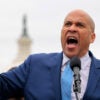For most of 2009, President Obama, Speaker Pelosi and Majority Leader Reid have been obsessed with a “public option” for health care, which would create a government-run health care system that would eventually monopolize the industry and create the single-payer system liberals have long desired.
Even when town hall protesters by the thousands jeered the concept; they stood by it. Even when poll numbers reflected a small minority of support; they stood by it. Even when study after study showed that millions of Americans would be forced out of their private plans, that it wasn’t paid for, and that it would lead to bureacratic rationing; they stood by it. But now, they have swiftly “compromised” by introducing the idea of a “trigger.” So what is a trigger, and why are liberals suddenly embracing this language?
What is a Trigger? A trigger is a legislative tool that would put in place automatic benchmarks that if not met, would immediately unleash the government-run system into the market. For example, if 95% of Americans as defined by the bill, don’t have adequate health coverage by a certain date, the public option would be “triggered.”
The Daily Signal depends on the support of readers like you. Donate now
Is a Legitimate Process? No. What a trigger does is hold off the tough decision until future, uncertain circumstances. The public option would essentially become law today, but not go into effect until an undetermined time when economic conditions could be even worse. It is a travesty of democracy because it allows legislators to vote for a plan now, but passes the blame for the catastrophic consequences onto their successors.
How Would ‘95%’ Be Determined? Whatever trigger number they come up with would be difficult to measure with any accuracy. What if a state hits the target by “covering” 99% of healthy people who rarely need a doctor (e.g. young adults) but leaves the same percentage of its sick population uncovered. Imagine the complicated rules that states would have to comply with to ascertain if they reached the target without fudging in this way. And imagine the gaming that would take place by governors who either want a public plan (who would then work to keep coverage below 95%) or who strongly don’t (who would then inflate coverage). So who decides if a state meets the target? A health panel? The health Czar in the House bill? President Obama?
Is This the Best Result for States? No. Who is to say what is the best approach for each individual state. Let’s say a state with a high uninsured rate like Texas (27% uninsured today) makes tremendous progress in expanding coverage using innovative market-based approaches not favored by the Obama Administration, and reaches 90% coverage. Is the Health Czar going to pull the trigger anyway and tell the state to stop what it’s doing and create a public plan instead? So states like, Arizona, California, Florida, Louisiana, Mississippi, Nevada, Oklahoma and Texas would likely be forced to accept a public plan no matter how much progress they had made. Meanwhile the main House bill waives ERISA protections to allow states immediately to put into place single payer systems. Quite a stacked deck!
Will a Public Plan be the Right Approach 5-10 Years From Now? Nobody knows, but most likely the answer is no. Triggering automatic imposition of the House public plan in 5 or 10 years, or whatever the time is before the trigger is pulled, means you lock in one view of the solution rather than anything learned in the meantime. Had Congress enacted a trigger to save Clintoncare, the trigger would have forced states to implement HMOs at exactly the time everyone was moving away from that overly rigid version of managed care. We don’t want to repeat that mistake.
Is There a Precedent for This? No. Some claim that the proposed trigger is simply what Republicans used as a fallback in the 2003 Medicare drug legislation, in case private plans did not emerge. That is absolutely untrue. The legislation actually prohibited a “governmental entity” or public plan as the fallback, stating that every plan sponsor must be a “nongovernmental entity.”
Who is Best Able to Fix the Problems With Health Care? The states. There is a good reason we have a federal system. It works. Encouraging states to experiment helped us fix the welfare system. If the federal government wants to push states to improve coverage it can set agreed targets with individual states. The states can propose ways of achieving those goals – including removal of bureaucratic and statutory rules that block innovation. If states don’t reach goals then trigger a new agreement with the state on how to improve progress, with the federal government helping to make it happen. Don’t trigger a 10-year old off-the-peg public plan and impose it on the state.






























